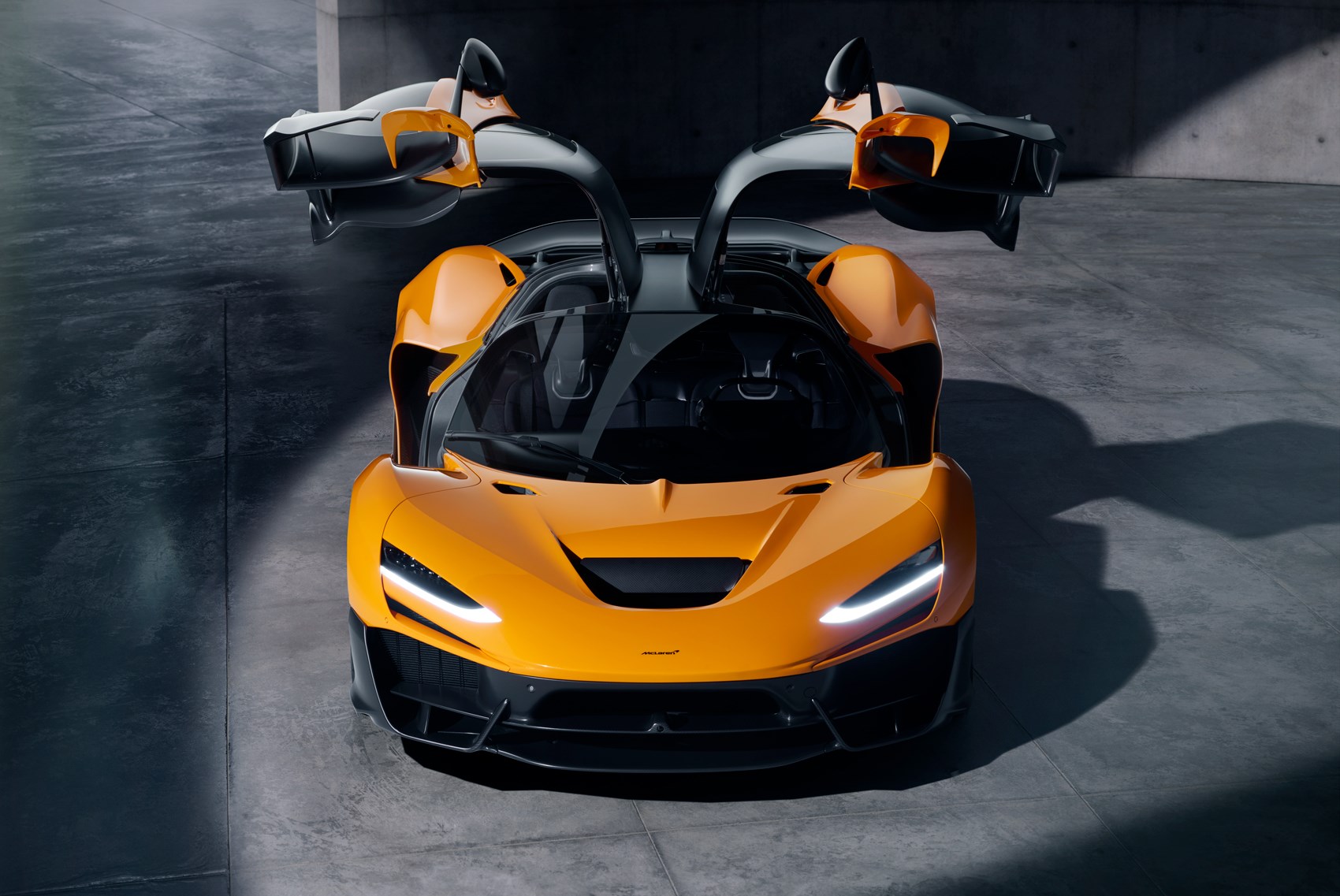► McLaren’s new W1 hypercar has arrived
► Hybrid powertrain develops 1258bhp
► Trick aero and plenty of cutting-edge engineering
This is the McLaren W1. It’s the next generation of Woking’s ‘1’ cars, and follows on from the F1 and P1 in the Ultimate Series. These are serious cars – vehicles at the very pinnacle of performance, technology and exclusivity.
McLaren announced the W1’s debut at 1pm BST on 6 October, precisely 50 years since Emerson Fittipaldi sealed the company’s first Formula 1 Drivers’ and Constructors’ World Championship victories at the wheel of the McLaren M23.
The letter W nodding to what the company calls its world championship mindset, this halo model is a £2 million trailblazer for McLaren’s path for the next decade.
That looks serious…
With a lineage that includes the Speedtail, Senna and Solus, McLaren’s knowledge banks in this niche are Wikipedia-like in size and value. Every aspect of the W1’s description-defying design is driven by the aerodynamics – the most advanced, ambitious, extreme and comprehensive McLaren has ever applied to a road car, it claims.
The W1’s complex bodywork is wrapped around what McLaren calls its Aerocell, an all-new motorsport-inspired prepreg carbonfibre tub designed from scratch to bring shapeshifting aero that delivers both massive downforce and minimal drag.
‘We’ve applied F1 aero techniques to redirect air under, through and over the car,’ says Robin Algoo, the W1’s lead aerodynamicist, who has spent half of his eight years at McLaren working on the W1.
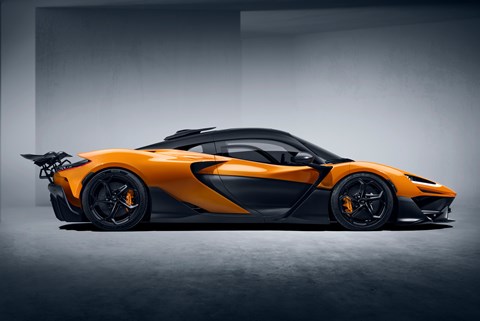
The result, explains Algoo, is that high-energy airflow travels cleanly down the centre of the car. ‘Front downforce is more evenly distributed, with the centre of pressure naturally closer to the centre of gravity, making the W1 less sensitive to pitch than cars with traditional front splitters. At the back, the Active Longtail wing extends up to 300mm rearwards – rather than vertically – and swings through 29º to position the leading edge of the wing behind the diffuser trailing edge.’
Nerdy aero as always then – what about power?
Behind the passenger cell sits the MHP-8, a new 3988cc V8 that shares nothing with the Artura’s M630 V6 or the M840T V8 in the 750S. The longitudinally-mounted 90° flatplane-crank unit, designed and developed by McLaren engineers, is manufactured by long-term supplier Ricardo. The all-alloy unit features both port and direct fuel injection at 350bar of pressure, and is breathed on by a pair of twin-scroll turbochargers.
The short-stroke engine revs to 9200rpm, higher than any previous road-legal McLaren, at which point it’s generating 915bhp, with 664lb ft of torque coming in from 4500rpm. With a specific output of 230bhp per litre, the MHP-8 generates 102bhp more than the Senna GTR.
That’s just the V8 engine. Like the P1, the W1 is a hybrid. A lightweight power-dense 1.384kWh battery, housed in the Aerocell’s floor, feeds a Nissan-derived radial-flux electric motor that adds 342bhp and a further 325lb ft for combined total outputs of 1258bhp and 988lb ft.
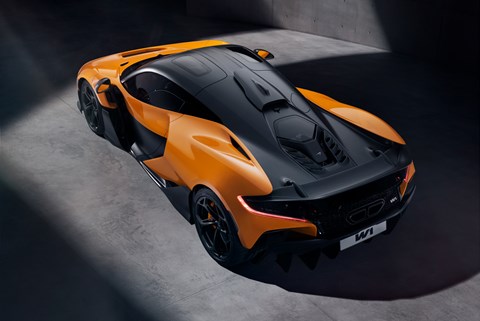
‘The W1 is the fastest-accelerating road-legal McLaren ever. It will accelerate to 60mph in 2.7 seconds, reach 124mph in 5.8 seconds and 186mph in 12.7 seconds,’ says W1 vehicle line director, Alex Gibson. ‘Top speed is electronically limited to 217mph. It will drive away from a Speedtail in a race to 185mph, and around the 6.2km handling circuit at the Nardo Proving Ground it’s three seconds a lap faster than a Senna.’
Three seconds a lap faster than a Senna… how is that even physically possible? Expect iterations of this engine and its technology to power future higher-volume road models.
That monstrous power and trick aero are supported by brakes, suspension and steering engineered to maximise driver control and confidence. The steering is hydraulically powered – no rear-steer or numb electric assistance here – for an unfiltered flow of information from the front axle.
The W1’s Brembo six-piston front and four-piston rear forged monobloc calipers may be standard equipment at this performance level – you’ll find them on the Ferrari SF90 XX Stradale, Porsche 911 GT3 RS and the Lamborghini Revuelto – but here they grab 390mm CCMR-Plus brake discs coated in an additional high-friction ceramic layer that McLaren claims will deliver both consistent braking performance and parachute-deployment levels of retardation: 124mph to standstill in 100 metres and 62mph to zero in just 29 metres.
The front and rear suspension componentry wouldn’t look out of place on the walls of a modern art gallery. Snappily labelled Race Active Chassis Control III, the W1’s complex suspension uses double wishbones front and rear, inboard springs and dampers, with rear active drop links and adaptive damping. There’s titanium componentry, and a lot of 3D-printed sexiness in the wishbones and the inboard active heave damper, which significantly increases vertical stiffness under braking, improving stability and reducing corner-entry oversteer.
What does the driver see inside?
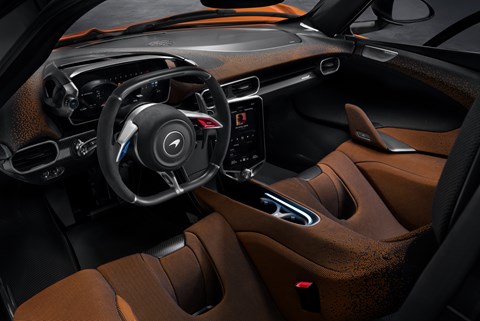
Swing up the driver’s door – take the time to gaze at the sculpted aero intricacies of its skin, and the titanium suspension that’s on view between chassis and front wheel – and you’re faced with a yawning aperture that makes cabin entry and exit a breeze. The two bucket seats are an integral part of the Aerocell, rather than independent bolt-in units.
Apart from the obvious structural benefits, this single-piece approach creates generous levels of room in all directions. The single-piece F1-style sliding pedal box and reach-rake steering wheel adjust around the fixed seats; extra padding and support are available if requested by customers.
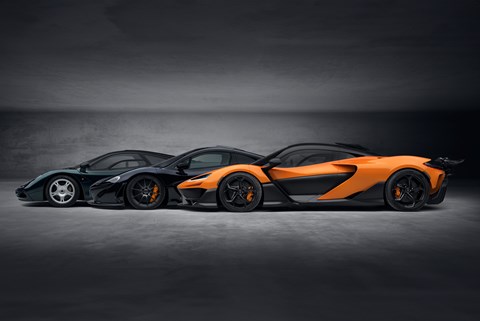
Can I have one?
Nope, sorry. Production is pegged at 399 units, with the first customers taking delivery in early 2026. They’re all spoken for.

